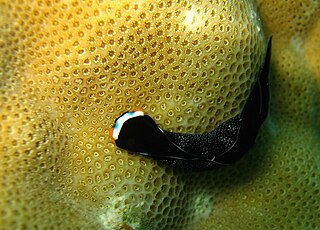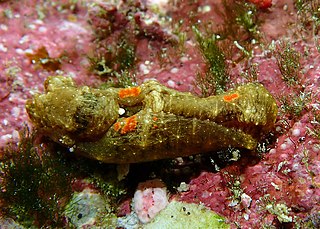
The order Cephalaspidea, also known as the headshield slugs and bubble snails, is a major taxon of sea slugs and bubble snails, marine gastropod mollusks within the larger clade Euopisthobranchia. Bubble shells is another common name for these families of marine gastropods, some of which have thin bubble-like shells. This clade contains more than 600 species.

Haminoeoidea is a taxonomic superfamily of small sea snails or bubble shells, marine opisthobranch gastropod mollusks in the clade Cephalaspidea, the headshield slugs and bubble snails.

Philinoidea is a taxonomic superfamily of sea slugs, specifically headshield slugs, marine gastropod mollusks in the order Cephalaspidea.

Aglajidae is a family of often colorful, medium-sized, sea slugs, marine opisthobranch gastropod mollusks. These are not nudibranchs; instead they are headshield slugs, in the clade Cephalaspidea.

Chelidonura is a genus of small, sometimes colorful, sea slugs. These are headshield slugs or cephalaspideans, marine opisthobranch gastropod mollusks in the family Aglajidae.

Mariaglaja inornata, also called the inornate headshield slug, is a species of sea slug or headshield slug, a marine opisthobranch gastropod mollusc in the family Aglajidae.

Melanochlamys is a genus of headshield slugs in the family Aglajidae. Despite the appearance of its species, this genus must not be confused with nudibranchs.

Aglaja is a genus of sea slugs, marine opisthobranch gastropod mollusks in the family Aglajidae. The genus is found in all warm and temperate oceans.

Siphopteron quadrispinosum is a species of small sea slug, a marine opisthobranch gastropod mollusc in the order Cephalaspidea, the headshield slugs. This slug is a simultaneous hermaphrodite.

Diaphorodoris is a genus of sea slugs, dorid nudibranchs, shell-less marine gastropod mollusks in the family Calycidorididae.

Diaphorodoris mitsuii is a species of sea slug, a dorid nudibranch, a shell-less marine gastropod mollusc in the family Calycidorididae.

Diaphorodoris papillata is a species of sea slug, a dorid nudibranch, a shell-less marine gastropod mollusc in the family Calycidorididae.

Diaphorodoris alba is a species of sea slug, a dorid nudibranch, a shell-less marine gastropod mollusc in the family Calycidorididae.
Felimare aurantimaculata is a species of sea slug or dorid nudibranch, a marine gastropod mollusc in the family Chromodorididae.

Melanochlamys cylindrica is a species of bubble snail in the family Aglajidae. It is endemic to New Zealand.

Tubulophilinopsis gardineri, the Gardiner’s philinopsis, or Gardiner's headshield slug is a species of sea slug, a shell-less opisthobranch gastropod mollusc in the family Aglajidae. It is native to the Indo-Pacific region.

Tubulophilinopsis is a genus of medium-sized, sea slugs from the Indo-West Pacific belonging to the family Aglajidae.

Navanax aenigmaticus common name the mysterious aglaja is a species of Navanax found in the Pacific Coast of Central America.
Philinopsis depicta is a species of sea slug, an opisthobranch gastropod mollusc in the family Aglajidae. It is native to the Mediterranean Sea where it lives on the sandy seabed in shallow water. It is a predator.
Aglaja tricolorata is a species of sea slug, an opisthobranch gastropod mollusc in the family Aglajidae. It is native to the Mediterranean Sea and the tropical eastern Atlantic Ocean where it lives in shallow water on the sandy seabed.


















